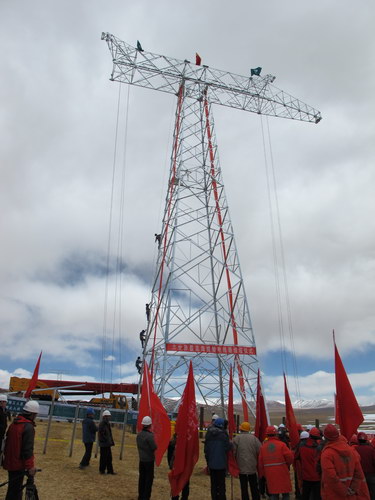Energy
Project to end Tibet's power shortages
Updated: 2011-05-17 10:18
By Du Juan (China Daily)
LHASA - Tibet's power shortages are expected to end once the Qinghai-Tibet Power Grid Interconnection Project is finished by the end of the year, connecting Tibet's grid to the national grid for the first time.
The project is now 60-percent complete, said Yu Xinqiang, general director of the project and head of the Northwest China Grid Company Ltd.
"The whole project will be finished one year earlier than planned," he said. "The grid will go into operation after it's completed."
| ||||
The project, into which 16.2 billion yuan ($2.5 billion) has been invested, stretches from Xining, the capital of Qinghai province, to Lhasa, capital of the Tibet autonomous region. It contains 750 kilometers (kms) of alternating-current transmission lines, running from Xining to Golmud, and 1,038 kms of direct-current line, running from Golmud to Lhasa.
Zhang Qingli, Party chief of Tibet, said the project is a priority for the State Grid Corp of China and will bring power and social stability over the long run and contribute to the prosperity of the region.
 |
|
The highest transmission tower of the Qinghai-Tibet Power Grid Interconnection Project. The grid is expected to end power shortages in the Tibet autonomous region. [Photo/China Daily] |
Tibet has become more and more prosperous in recent years, as the amount of power it uses has shown annual double-digit percentage increases. The central government has placed a priority on ensuring the region is well-supplied with power, said Yu.
Tibet mainly relies on hydroelectric power, which is easier to produce in certain seasons than others. Large power shortages often arise in the winter when water becomes too scarce to meet the demand for electricity.
According to the State Electricity Regulatory Commission, Tibet consumed 2 billion kilowatt hours (kWh) of electricity in 2010, 15 percent more than it had in the previous year.
Even so, only the middle region of Tibet is expected to have a large power shortage. Forecasts hold it will lack about 30 percent of the 1.1 billion kWh of electricity it will need this year, said Liu Xiaoming, general manager of Tibet Electric Power Co Ltd.
Yu said the new power grid can transmit 600,000 megawatts (mW), and modifications can be made to the grid to increase that amount to 1.2 million mW if the demand for power rises high enough.
He also said the company is planning to start another power-grid project, this one running from Hami in Xinjiang Uygur autonomous region to Golmud. Once that project is finished, the two new grids in western China will help to ensure the region can draw enough power to support the development of its economy.
E-paper

Thawing out
After a deep freeze in sales during the recession, China’s air conditioner makers are bouncing back
Cool Iron lady
Of good and evil
Build on security initiatives
Specials

The song dynasty
There are MORE THAN 300 types of Chinese operas but two POPULAR varieties are major standouts

Cut above the rest
One of the world's oldest surgeons has performed more than 14,000 operations

From the ground up
Architect of Guangzhou Opera House has many projects under way, including 2012 Olympics.




